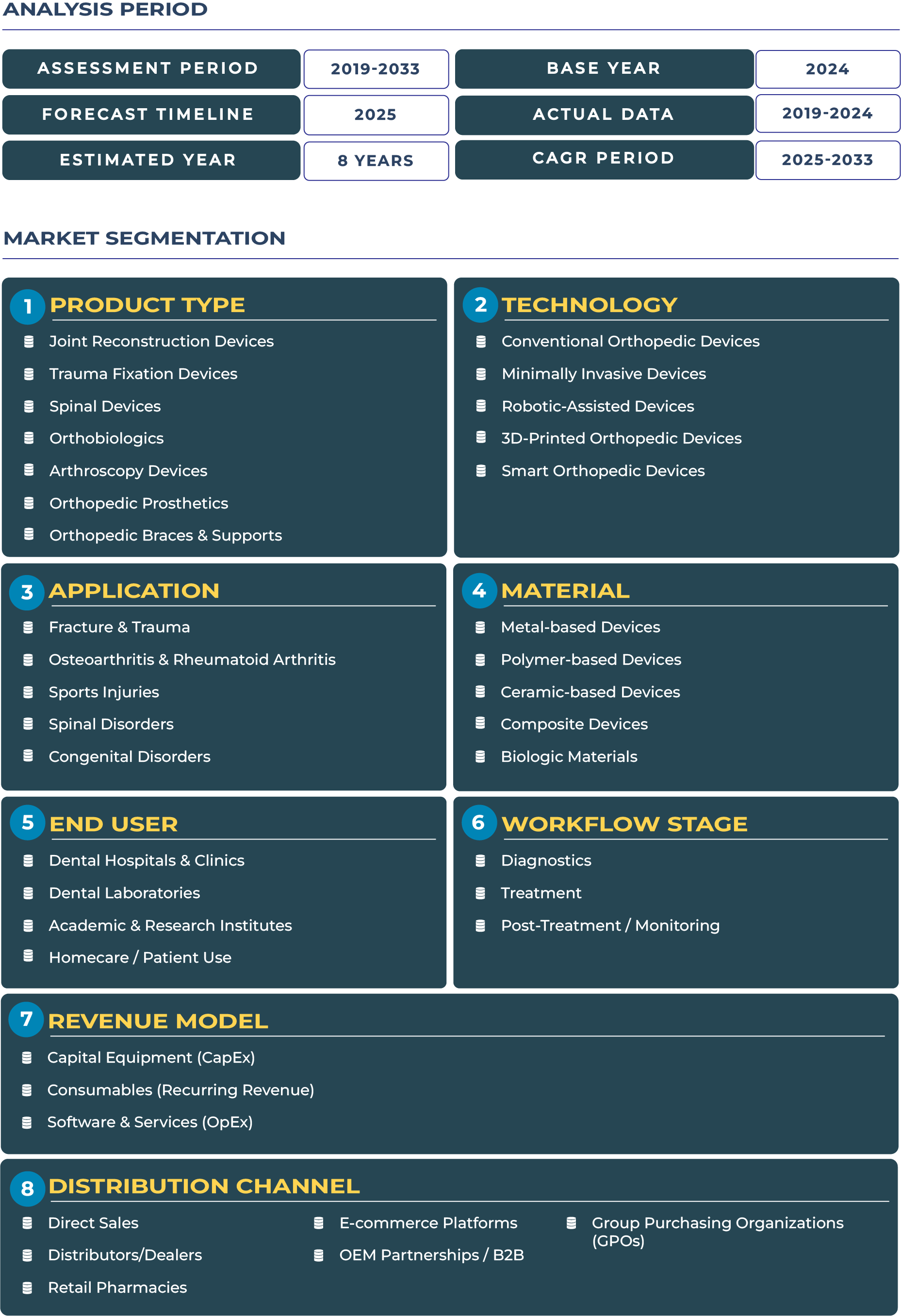China Orthopedic Devices Market Outlook: Balancing Demand and Manufacturing Strength
China has emerged as both a powerful demand center and a global manufacturing hub for orthopedic devices, positioning itself uniquely in the healthcare technology value chain. The country’s aging population, urban healthcare expansion, and policy-driven reforms are fostering significant demand for joint reconstruction implants, trauma fixation systems, and spinal care solutions. Simultaneously, China’s local manufacturing strength and extensive network of Original Equipment Manufacturers (OEMs) are enabling scale-driven innovation, giving domestic companies a competitive edge in both cost and accessibility. By 2025, the China orthopedic devices market is estimated at USD 4.50 billion, projected to reach USD 8.29 billion by 2033, growing at a CAGR of 7.9%. This expansion is fueled not only by medical demand but also by government reforms that promote localization, supply chain resilience, and innovation-driven healthcare ecosystems.
China Orthopedic Devices Market Enters a Decade of Reform, Innovation, and Localization
The outlook for China Orthopedic Devices market is defined by the dual forces of rising patient demand and systemic healthcare transformation. With its vast aging population—projected by the National Bureau of Statistics of China to exceed 400 million people aged over 60 by 2035—orthopedic procedures are expected to rise substantially. High-volume demand spans from hip and knee replacement to trauma fixation devices, making orthopedic care a core component of China’s healthcare roadmap.
At the same time, government-led healthcare reform is accelerating hospital modernization and incentivizing procurement of domestically manufactured devices. These initiatives align with the National Health Commission of China directives to strengthen local innovation, particularly in joint reconstruction and spinal care implants. The result is a market environment where local players hold increasing market share, while global companies adapt through partnerships and joint ventures to maintain relevance. Between 2025 and 2033, market growth is expected to accelerate as reforms, digital transformation, and regional hospital expansions converge to create new demand channels.
Drivers & Restraints: Balancing Scale with Policy Pressures in the Orthopedic Devices Landscape
Drivers of Growth: The orthopedic devices industry in China benefits from massive procedure volumes driven by aging demographics, lifestyle-related bone disorders, and road accident-related trauma cases. Tier-1 hospitals in Beijing, Shanghai, and Guangzhou are leading the adoption of advanced arthroscopy devices and robotic-assisted surgery platforms, accelerating clinical efficiency. Furthermore, strong domestic OEMs such as MicroPort Orthopedics leverage economies of scale and cost advantages to supply high-quality implants across multiple provinces. Rapid hospital modernization, supported by healthcare infrastructure investments, is creating an ecosystem where advanced spinal devices and orthobiologics can penetrate more widely.
Restraints on Growth: However, the sector faces challenges that temper growth. Reimbursement frameworks vary by province, creating administrative complexity for device adoption. Regulatory scrutiny, particularly targeting imported implants, has increased under “Made in China 2025” policies, compelling international firms to localize manufacturing and comply with stricter market access conditions. Price competition from local OEMs exerts additional pressure on international companies, particularly in joint reconstruction and orthopedic prosthetics segments where cost sensitivity is high. These restraints highlight the importance of strategic adaptation for global players seeking long-term resilience in China Orthopedic Devices sector.
Trends & Opportunities: Robotics, Domestic Leadership, and Regional Expansion Shaping the Orthopedic Devices Ecosystem
Major Trends: One of the most transformative trends is the rapid adoption of robotics and navigation-assisted orthopedic surgery in Tier-1 hospitals. These technologies enhance precision in knee and hip replacement procedures while also fostering patient trust in advanced care. Additionally, local OEMs are steadily gaining market share by offering affordable and innovative products designed for local patient demographics, a trend reinforced by government incentives. Digital health integration and clinical outcome analytics are also gaining traction, especially in Shanghai and Shenzhen, where connected care ecosystems are being tested to support post-surgical rehabilitation and long-term patient monitoring.
Key Opportunities: Strategic partnerships with domestic OEMs present international companies with an opportunity to navigate regulatory barriers while maintaining relevance. Clinical data collaborations with Chinese hospitals are becoming vital to secure government approval and adoption of new orthopedic technologies. Furthermore, city-level hub expansions, particularly in western provinces such as Sichuan and Chongqing, represent untapped growth potential. Expanding access beyond Tier-1 cities not only diversifies market exposure but also aligns with national goals of healthcare equity and modernization.
Competitive Landscape: Local Giants and Global Brands Redefining Market Strategies
The competitive landscape of China Orthopedic Devices industry is marked by both consolidation and innovation. Local leaders like MicroPort dominate joint reconstruction and trauma fixation devices, while global companies such as Johnson & Johnson and Zimmer Biomet maintain presence through partnerships and localized R&D centers. In 2024, MicroPort expanded its orthopedic robotics platform to additional provinces, signaling aggressive investment in high-value technologies. International players have responded with strategies such as joint ventures, licensing agreements, and provincial clinical evidence generation. These approaches not only mitigate regulatory headwinds but also enable faster rollout of affordable solutions across city hubs. The dynamic interplay of domestic dominance and international adaptation continues to define the orthopedic devices ecosystem in China.







